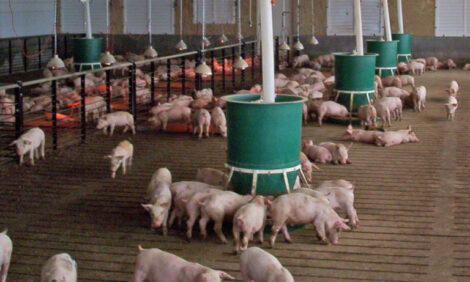



UK Pig Disease Surveillance Report (January - March 2008)
By Veterinary Laboratories Agency - This report monitors trends in the major endemic pig diseases and utilises the farmfile and VIDA (Veterinary Investigation Disease Analysis) databases. The report is compiled using disease data gathered by the network of 15 VLA regional laboratories which carry out disease investigation in the field.
 January-March 2008 Published May 2008 Contents HIGHLIGHTS NOTIFIABLE DISEASES ZOONOSES & FOOD SAFETY OVERVIEW OF PIG INDUSTRY HIGHLIGHTS OF ENDEMIC DISEASE SCANNING SURVEILLANCE FOR NEW & EMERGING DISEASES PUBLICATIONS |
HIGHLIGHTS
No notifiable diseases of pigs were recorded in the first quarter of this year.
No Food Safety Incident concerning pigs was recorded in the first quarter this year.
Salmonellosis remains the most significant potential zoonosis. Salmonellae were isolated from 10.97% of the samples this quarter. Salmonella enterica enterica Typhimurium accounted for 78% of the cases (18/23) and U288 (50%) predominates with DT193 (36%). Of the other salmonellae Reading and London were found. Salmonella Enteritidis PT6 was also isolated from pigs. No S. cholerae-suis were found.
The demand for ZAP visits was much reduced in this period. Only 14 new visits were carried out and salmonellae were isolated from 28% of the samples.
Streptococcus suis type 2 still accounts for many of the isolates serotyped this quarter. No zoonotic incidents were recorded.
VTEC O157 was not found in any of the pig submissions of the enhanced E.coli surveillance.
HIGHLIGHTS OF ENDEMIC DISEASE SURVEILLANCE
Analysis of the submissions without a diagnosis did not indicate the emergence of a novel pig disease during the first quarter of 2008.
No new and emerging diseases or recrudescence of old disease as a significant endemic disease has occurred in pigs.
No new strains of avian and/or swine influenza have been seen in this first quarter of 2008 and few isolations of viruses were made.
PRRS and PMWS/PCV2 continue to be the main causes of pig morbidity and mortality.
Reproductive failure and myocarditis are still not a large problem with PCV2.
HIGHLIGHTS FOR THE THIRD QUARTER OF 2007
SALMONELLAS AND SALMONELLOSIS: Salmonellosis continues to be a relatively rare occurrence in pigs. Isolation of salmonellae particularly S. Typhimurium continues to be a common occurrence.
PIG RELATED QUARTERLY SUBMISSIONS, MAIN CLINICAL SIGNS: These were similar to the ones for the last few years being related to wasting, diarrhoea in its various forms and the occurrence of coughing or dyspnoea.
DIAGNOSIS NOT REACHED (DNR): For the first quarter of 2008 the overall diagnosis not reached was 17.6%.
PMWS: The condition continues to be lesser importance as the clinical effects are reduced with careful attention to the use of alternative boars and crosses particularly involving the Pietrain. Hybrid vigour particularly associated with Landrace animals, which appear resistant to PRRS may also be associated with this improvement (recent Roslin research).
THE IMPROVED POST-WEANING MORTALITY FIGURES ARE A TESTAMENT TO THE PROGRESS THAT HAS BEEN MADE UNDER THE AUSPICES OF B-PEX.
Those producers who have tried the Merial vaccine in sows (now on general release) and the Boehringer vaccine for piglets (under ATC licence) have been impressed with their performance in reducing mortality and improving production characteristics.
PRRS: The overall summary is that there is much more diversity now than there was at the start of the outbreak 15 years ago. Many of the new strains are similar to vaccine strains. We do not know the ability of the commercial vaccine strains to protect against the myriad of new strains.
It is still difficult to make a herd diagnosis by isolating a strain from a single pig and multiple samples are necessary.
RESPIRATORY DISEASE: Nothing has changed in the rest of the respiratory disease field (except for PRRS and PCV2) certainly from the gross and microscopic point of view.
Actinobacillus porcitonsillarum was possibly isolated at VLA Sutton Bonington and was sent to VLA Bury St Edmunds for confirmation which is continuing. This is a non-pathogenic Actinobacillus species that does however produce the cytolysin Apx IVa.
A. urae has not been isolated from any further abortion cases.
SWINE INFLUENZA: There are no new indications of new influenza strains in pigs.
REPRODUCTIVE DISEASE: In this first quarter of 2008 few problems were encountered.
ALIMENTARY DISEASE: No new patterns of disease were seen.
MYCOPLASMAS: A Pfizer sponsored project to assess the virulence of Mycoplasma hyorhinis strains in piglets has shown for the first time in Europe that some strains of M. hyorhinis cause severe enzootic like lung lesions in pigs.
A review on the current state of knowledge of the epidemiology of M. hyopneumoniae infection including its transmission, infection and seroconversion dynamics as well as epidemiological tools has just been published (Sibila et al., 2008).
Mab XXXX for M. hyopneumoniae is ineffective when used for immunocytohistochemistry as it only detected 16 out of 33 positive pigs (IOM 2008 abstracts).
Another review describes research on the pathobiology of Mycoplasma suis an uncultureable haemotrophic Mycoplasma (Hoelzle, 2008). He also proposes that the disease caused by M. suis be renamed as infectious anaemia in pigs (IAP). M. suis invades porcine erythrocytes (IOM 2008 abstract).
Enzootic respiratory diseases in pigs in Switzerland appear to have been successfully controlled following a national disease control program that started in 1993 (Stärk et al., 2007). Bandrick et al., (2008) demonstrated the passive transfer of immunity to off spring from vaccinated sows. This information has implications for defining disease intervention strategies. Mycoplasma Submissions January – March 2008: 26 samples from 19 cases were submitted to the group. M. hyopneumoniae was identified once from lungs and once mixed with M. hyorhinis. Additionally, M. hyorhinis was detected 13 times from lungs and twice mixed with M. hyosynoviae from joint samples. M. hyosynoviae was identified in eight samples, 4 lungs and 4 joint samples from the same submission. M. arginini was also identified from viscera.
PIG-RELATED QUARTERLY SUBMISSIONS: (Provisional fourth quarter 2007 data)

In comparison with the first quarter of 2007, total and total diagnostic submissions were 14% lower this quarter. Diagnostic carcase submissions were 29% lower than the corresponding quarter in 2007. This reflects the continued financial problems within the pig industry.
Analysis of ‘main clinical sign’ reported with diagnostic submissions did not indicate any major changes during this first quarter compared with the average for the whole of 2007.
Differential diagnosis of PMWS and/or ileitis was one of the most common reasons for submissions.
Further Reading
|
|
- You can view the full report by clicking here. |
July 2008








